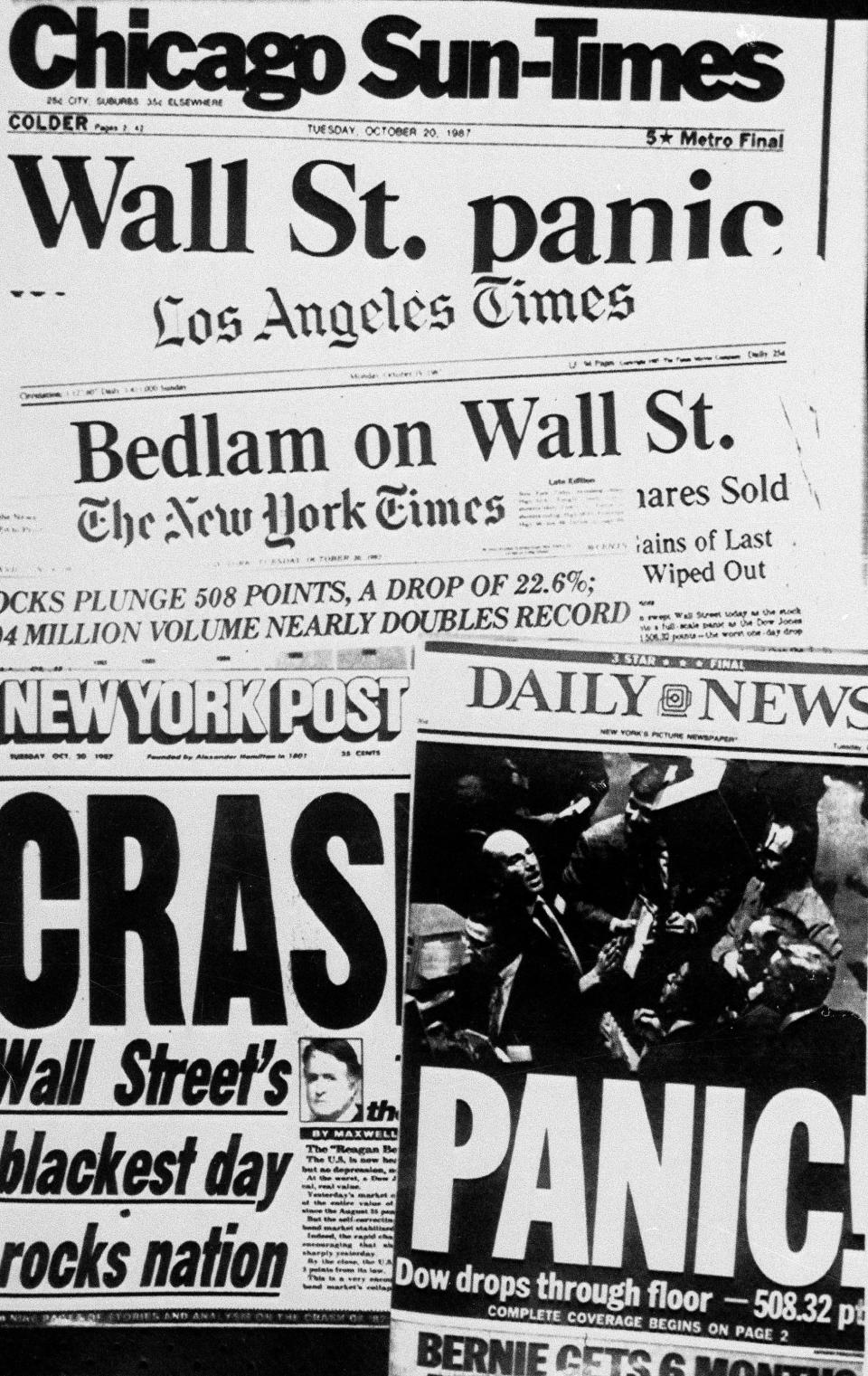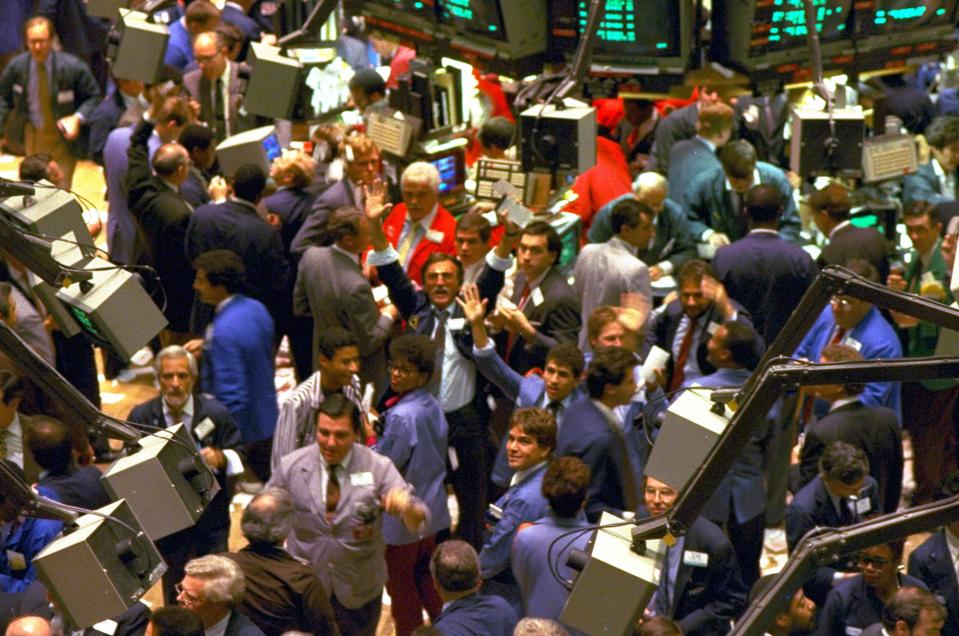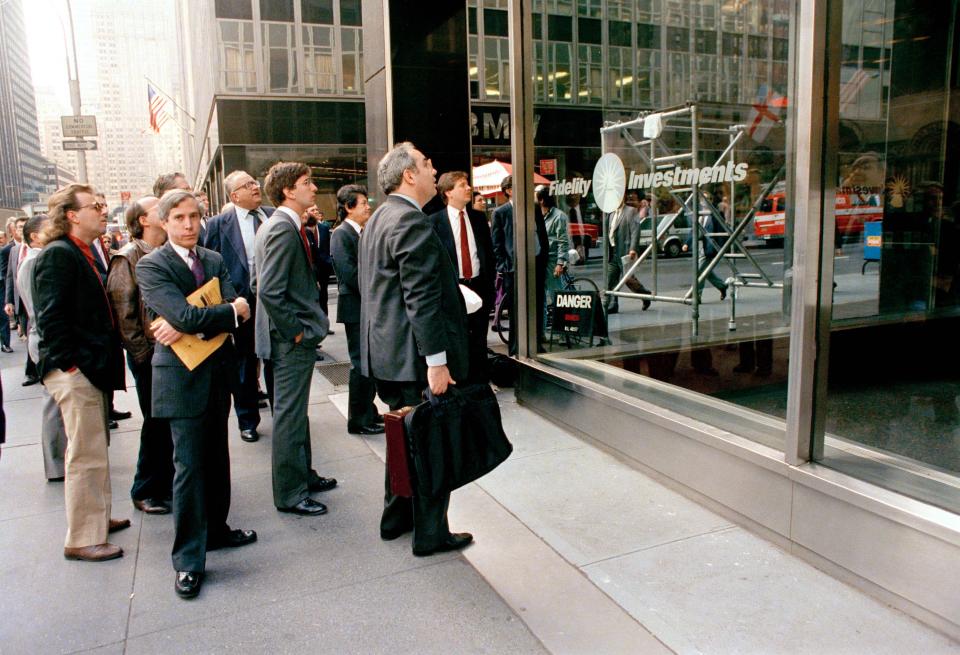From the archives | Dow's 500-point crash: Market pros fear further fall of stocks
This story originally published on Oct. 20, 1987. It is being republished as part of the commemoration of USA TODAY's 40th anniversary on Sept. 15, 2022.

NEW YORK — It was the Crash they promised us could never happen again.
As panicked investors scrambled to grab what money they had left, the Dow Jones industrial average spun into a dizzying free fall, losing 508.32 points to close at 1738.41 Monday. The Dow's one-day loss of 22.6% destroyed the record set by the 12.8% plunge on Oct. 28, 1929, Black Monday. Volume was a staggering 604.33 million shares, shattering Friday's record of 338.5 million.
"It's a worldwide financial panic,'' said Hugh Johnson, analyst at First Albany Corp. "People are scared to death.''
Hard-nosed Wall Street professionals could not hide their cracking voices – a few veterans even broke down and cried during phone calls. Their greatest fear: that once again the stock market is anticipating events. In 1929, experts said they could not understand why stocks were crashing; the economy appeared healthy. In 1987, experts are saying the same thing.
"This is very, very frightening,'' said Susan Grossman, a well-respected broker at Tucker, Anthony & R.L. Day. "The market is going to 800. There is no doubt in my mind.''
William Doane, money manager at Minuteman Financial Services in Lexington, Kentucky, said quietly, "My stomach bothers me.'' It's tough to even try to make sense of how low the market can go "when you're snowballing like this,'' Doane said.

But some did try to sort through the carnage and take qualified stabs at guessing where the purge might end. The consensus: A Dow at 1700, which could be reached as early as today if stocks continue down.
Grossman expects the Dow to plunge through important "stopping points'' at 1725, 1375, and 1082, on its way to a decline she thinks will stop where the bull market began in August 1982 - at 800. "The bull market is history,'' she proclaimed.
Professionals saw few hopeful signs. Doane pointed out that "Tuesdays historically have been good reversal days'' after tremendous market sell-offs. "But that's not to say this is the low,'' he quickly added. After a three- or four-day rally, damaged markets typically "test'' their recent lows, he said. Only then can we tell whether the market will hold at current levels, or continue the plunge.

As analysts searched for answers to the question "What next?'' they looked to history. Though admitting there is no perfect historical precedent, they did look at:
Previous panic selling
Edward Renshaw, professor of economics and finance at the State University of New York at Albany, has studied the eight times since 1940 that the market has dropped 4.5% or more in one day. After five of the nine declines, the market rose between 2.3% and 36.9% in the following year; it fell the other three times, but two of the drops were ``trivial.'' Last Friday's 108.36-point Dow plunge was the ninth panic day since 1940; Monday was the tenth. If history repeats, ``I should think there are a lot of bargains out there,'' Renshaw said.
Technical 'support levels'
Those are the spots on the Dow where the market has previously shown strength. Technical analysts – who watch stock charts for hints of direction – say the market tends to stay above those levels. Gail Dudack, technician at S.G. Warburg & Co., said the Dow has "support'' between 1750 and 1900. But "in a market like this, which is 90% emotion, support levels don't have much meaning. It's really a matter of where we stabilize emotionally.''
Psychology
Investors' nerves are being rattled by everything from the threat of war in the Persian Gulf to a feeling that President Reagan's effectiveness as a leader has been reduced by his lame-duck status. Ken Hackel of Systematic Financial Management in Fort Lee, N.J., said bad news in the financial markets kicked in "with a very slight lag'' after the appointment of Alan Greenspan in August as chairman of the Federal Reserve Board. "When you have a lame-duck president and lack of confidence in the Fed chairman,'' it can lead to a shift in investor psychology, he said. Making prospects more bleak to some: congressional efforts to thwart the spate of mergers – which played a big part in fueling the five-year bull market.
Programs
Much of the current panic derives from computer-driven program trading - which has made the market even more volatile than it was in 1929. Professionals use computers to trade both stocks and futures tied to the performance of stock indexes. They play the two off each other in an effort to make the most profit. That buying and selling of futures and stocks has been causing huge market swings for several years. Renshaw and others were adamant Monday that futures trading game should be stopped. ``This panic is going to demonstrate that we really have to prohibit'' program trading, he said. ``This is really a kind of Star Wars type panic.''

The economy
The 59-month economic recovery is old by historical standards - a worry to economists who are, in increasing numbers, fearing recession. Hackel argued that that once the excesses are completely out of the market, this year's healthy corporate profits again will get Wall Street's attention. But if interest rates remain high, a recession could come next year, said Gary Ciminero, economist at Fleet Financial Group. "These are killer rates, with housing and consumption being key casualties.''
Interest rates
Yields on 30-year Treasury bonds fell Monday to 9.94%. But the bonds still are a relatively risk-free lure for investors frightened by the risk of stocks. Although the Fed always feels the pressure to keep rates down, West Germany and Japan have raised their interest rates, forcing USA rates up to remain competitive. Yields on the 30 Dow stocks declined to under 3% in the heady days of August. Norm Zadeh, a private trader who runs a stock-trading contest in Beverly Hills, California, says a Dow at 1750 finally would put stock and bond yields in line with one another. Meanwhile, "Long-term bonds are a very good buy at these levels,'' said Ciminero.
Ciminero worries most of all that the loss of $150 billion in shareholder holdings last week alone could itself lead to a serious recession. ``People feel a lot poorer since last Friday.''
Dow's 500-point crash
Dow Jones industrial average, Monday, 4 p.m. - 1738.74
How key indexes crashed including Monday declines and the percentage change
Dow industrials 1738.74 -508.00 -22.6%
S&P 500 224.84 -57.86 -20.5%
PSE tech.stocks 118.37 -29.12 -19.7%
NYSE composite 128.62 -30.51 -19.2%
Dow transports 776.87 -164.78 -17.5%
Dow utilities 160.98 -29.16 -15.3%
Amex market value 282.50 -41.05 -12.7%
OTC comp. 360.21 -46.12 -11.4%
The five worst one-day percentage drops of the Dow 30 stocks:
Oct. 19, 1987 -22.6%
Oct. 28, 1929 -12.8%
Oct. 29, 1929 -11.7%
Nov. 6, 1929 -9.9%
Aug. 12, 1932 -8.4%
This article originally appeared on USA TODAY: Stock market crashes, experts don't understand why

